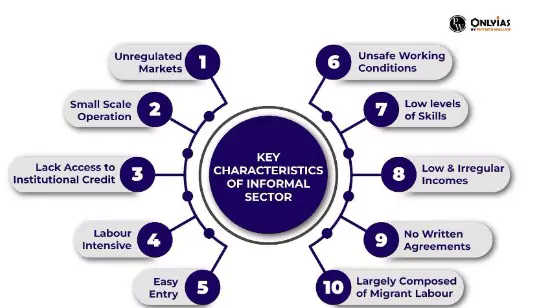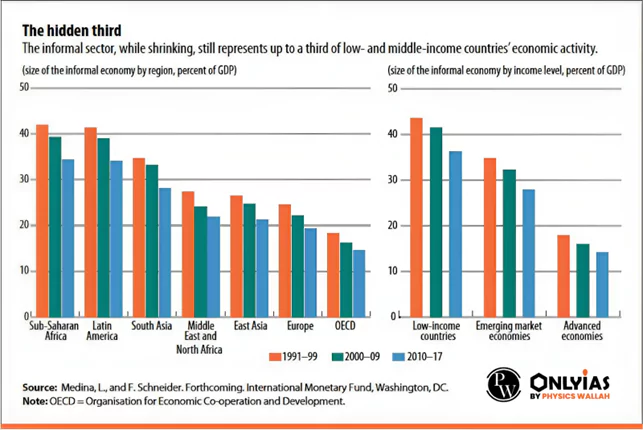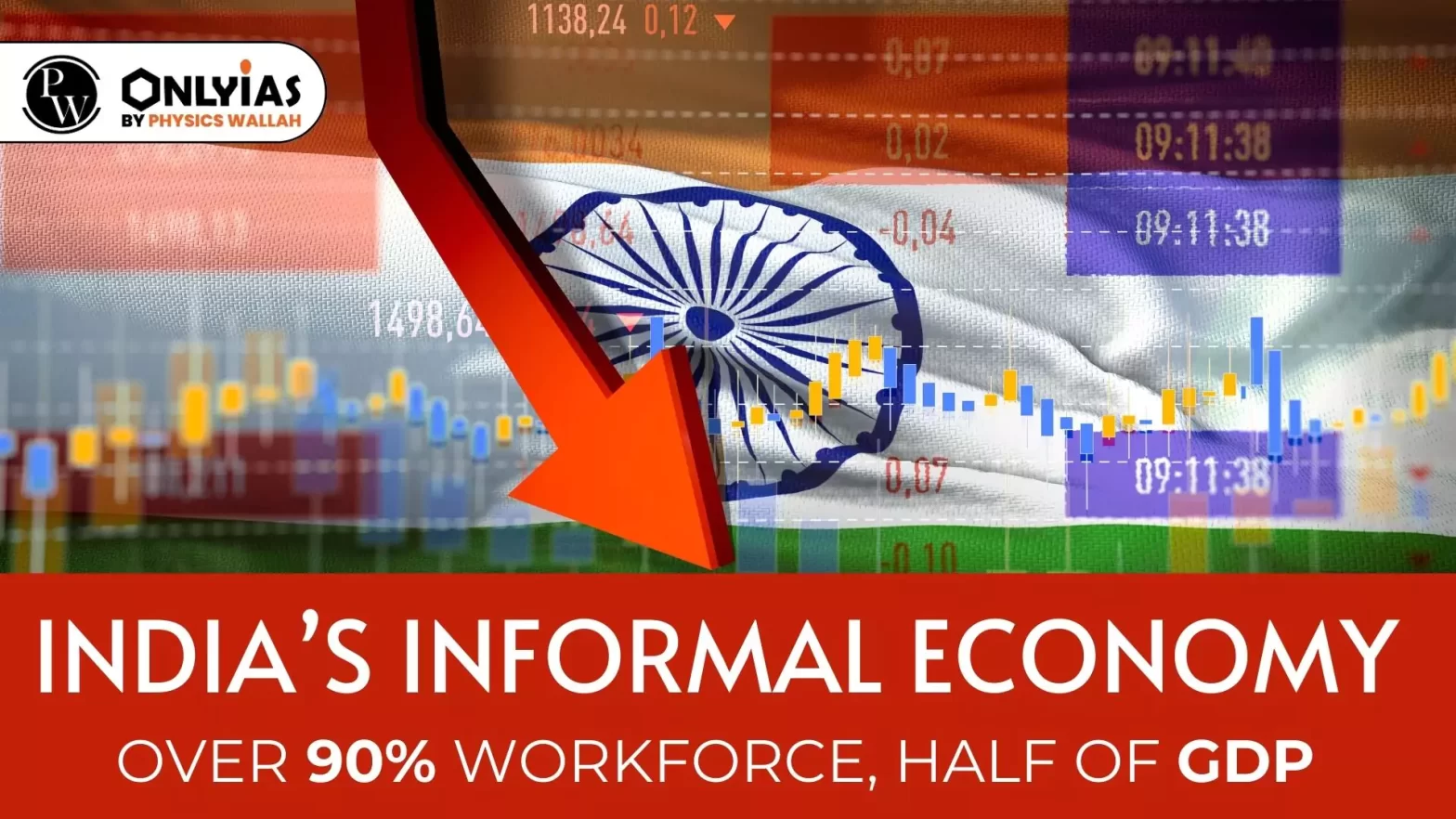Context:
- This article is based on the news “India’s war on informal labour is turning out bad for workers” which was published in the Mint. According to the annual Periodic Labour Force Survey Report (PLFS) 2022-23, 74% of non-farm workers are in proprietorships and partnerships, officially classified as informal sector enterprises.
| Relevancy for Prelims: India’s informal economy, Informal sector, India’s GDP Growth Rate, Workforce, and Goods And Services Tax (GST).
Relevancy for Mains: Periodic Labour Force Survey Report 2023, Informal economy of India, Problems with the India’s informal economy, and Government initiatives are in place to formalize the Indian Economy. |
India’s Informal Economy Dominance: Over 90% Workforce, Half of GDP

- While the informal sector produces almost half of the country’s GDP, more than 90% of the overall workforce is employed in the informal economy.
- According to e-Shram portal, over 94% of the informal sector workers enrolled on the e-Shram platform earn less than Rs 10,000 per month.
- Agriculture ranks first, accounting for 52.11% of all enrolments, followed by domestic and household employees and construction workers.
- The social-security benefits remain available to only around half of people working for a salary.
What is Informal Economy?
- Definition of Informal worker: According to OECD employees are considered to have informal jobs if their employment relationship is, in law or in practice, not subject to national labour legislation, income taxation, social protection or entitlement to certain employment benefits (advance notice of dismissal, severance pay, paid annual or sick leave, etc.)

Over 90% of workers in India are informal and out of these, those engaged in rural areas (dominated by farm and agriculture activities) are significantly more than those of urban areas.Informal employment lacks a written contract, paid leave, and may not pay minimum wages or pay attention to working conditions.
- Informal businesses includes: Street vending, artisanal production, home-based businesses, local transport workers, shop workers, domestic servants, community services like street cleaning and garbage collection, small workshops like shoe makers, garment makers, and embroiderers etc.
Also read: Nobel Prize 2023: Insights on Indian Women at Workforce
Key Terms
- Formal Economy: The part of an economy of which the government is fully aware and that is regulated by government authorities, particularly in the areas of contract and company law, taxation and labour law.
- Informal Economy: It refers to all economic activities by workers and economic units that are not covered or insufficiently covered by formal arrangements. The informal economy does not cover illicit activities.
|
What are the problems with the informal economy?
- Tax Evasion: Informal economy’s firms are not directly regulated and they typically evade one or more taxes by concealing revenue and expenses from the legal system.
- Stunted Middle Class: Informal sector destroys workers’ effort to get ahead and become middle class regardless of the capability for hard work and a highly entrepreneurial spirit.
|
What are the challenges associated with the formalisation of the Indian informal economy?
- Goods And Services Tax (GST) and Associated Complications: It is assumed that the higher revenue collections mean a more formal economy and vice versa. However, in trying to maximize GST collection, policymakers have made the GST extremely complicated.
- For instance, the productivity gains from the GST unifying the country into a single market have gone almost entirely to large businesses and digital startups whereas the compliance burden has put smaller firms at a disadvantage.
- Lack of Yields from Industrial Policy: A five-year package of $24 billion in production-linked incentives is provided to those who are willing put up factories.
- However, By September 2022, the program had managed to create fewer than 200,000 jobs.
- High Uncertainty Regarding Job Security: The high insecurity due to a high degree of economic informality is making even some PhDs and engineers graduates to compete for a government office for stability of tenure and retirement benefits.
- Aging Population: By 2050, India’s elderly population would more than double to 350 million. This low-productivity work offers less chance to save for old age or medical emergencies.
- Social Challenge: Social norms and safety concerns curbs physical mobility of women who make up the majority of informal participants, yet they face lower salary, income volatility, and a lack of a strong social safety net.
- Meanwhile, Dalits, the caste groups at the bottom of a repressive, hierarchical ladder, are stuck in casual, daily-wage work.
- Manufacturing and Service Sector: A significant proportion of the manufacturing sector is fragmented and carried out mostly by small and micro enterprises, which do not possess the competitive efficiency to grow and create formal jobs.
- Access to Financing: The domestic credit-to-GDP ratio compares credit to people and businesses to the economy.
- The World Bank reports that India’s private sector domestic credit at 55% of GDP in 2020 is well below the global average (148%) and below China (182%), South Korea (165%), and Vietnam (148%).Way Forward:Formalizing Informal Sector: Bringing informal workers and economic units under the coverage of formal arrangements.
- For example, Material Recovery and Segregation Facility (MRF) in North Delhi provides formal employment to waste workers.
- Creation of Database: There are no official statistics available that reflect the true state of the informal economy making it sector with “invisible workforce”.
- As part of the National Data System, a comprehensive statistical base on many elements of the informal economy is required to enable policymakers to make informed decisions.
- Equal Wages and Salaries: Equal compensation for equal effort is a directive principle of state policy (Article 39(d)), but women farm laborers typically earn less than their male colleagues.
- Through appropriate legislative support and its proper implementation, the government should enhance and enforce this DPSP
- Rationalising Regulations: There is a need to relax restrictions for formal business conduct in order to pull informal work into the fold of formality.
- Collective Working: There is a need for workers to collaborate with others with complementary skills so that they can collectively perform and benefit from complex and high value-added tasks that none of them could do on their own.
What Government Initiatives are in Place to Formalize the Indian Informal Economy?
- Introduction of the Goods and Services Tax (GST)
- Digital Payment System
- Production-Linked
- Make in India
- PM Vishwakarma Scheme
- E-Shram Portal
- Labour Codes
- Pradhan Mantri Shram Yogi Maan-dhan
- PM SVANidhi
- Pradhan Mantri Kisan Samman Nidhi
- World Bank Support to India’s Informal Working Class
|
Conclusion:
India’s informal economy, comprising over 90% of the workforce, faces challenges such as tax evasion, limited social security, and hindrances to formalization; addressing these issues requires comprehensive measures, including database creation, equal wage enforcement, and rationalizing regulations to uplift the vast “invisible workforce” and integrate them into formal arrangements.
| Prelims Question (2015)
With reference to Indian economy, consider the following:
1. Bank rate
2. Open market operations
3. Public debt
4. Public Revenue
Which of the above is/are component/components of Monetary Policy?
(a) 1 only
(b) 2, 3 and 4
(c) 1 and 2
(d) 1, 3 and 4
Ans: (c) |
![]() 19 Oct 2023
19 Oct 2023



